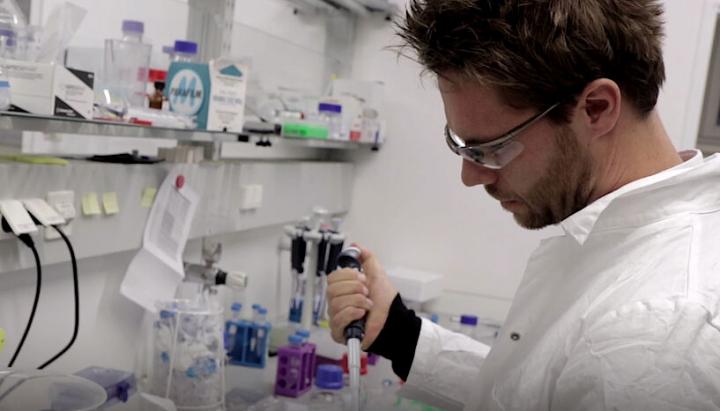Milestone for therapeutic development of peptides against gastrointestinal disorders

Credit: © Universität Wien
The three known human trefoil factor family peptides TFF1, TFF2 and TFF3 are mainly produced by the gastrointestinal mucosa. Named after their trefoil-like folded structure, the molecules provide clinically intriguing properties. Studies demonstrated that these peptides are locally produced to combat inflammation and injuries of the gastrointestinal tract by accelerating wound healing. Therefore, they have a considerable therapeutic potential for gastrointestinal and other mucosal disorders such as the dry eye disease and asthma as the researchers state in an additional review article published in ACS Pharmacology & Translational Science.
Local effects
“To date, there are two oral peptide therapeutics against diseases such as irritable bowel syndrome on the market,” says the medicinal chemist Muttenthaler. “Due to the relatively large size of the molecules, they are not being absorbed through the gastrointestinal wall into the bloodstream, and therefore can only act locally in the gastrointestinal tract without major side effects.”
The trefoil factor family is “an essential starting point for new therapeutic strategies to treat chronic diseases that remain incurable”, explains Muttenthaler, who leads research groups at the Department of Biological Chemistry at the University of Vienna and at the University of Queensland in Brisbane. The studies are being conducted in the context of Muttenthaler’s ERC Starting Grant project, which aims at disclosing the mechanisms of wound healing in the gastrointestinal tract. “Based on the chemical synthesis of the TFF peptides, we can now find answers to fundamental questions that we were not able to tackle before.”
TFF1 acts as homodimer
In their study, the researchers present the chemical synthesis of TFF1 and its homodimer, a molecule that comprises two TFF1 subunits. Only in its homodimeric form was TFF1 able to interact with mucins, main structural constituents of the gastrointestinal tract, which accelerates the closure of the mucosal barrier and its healing process.
With a length of 60 amino acids, conventional approaches were not applicable for the synthesis of TFF1. The scientists developed a new method to synthesise the peptide in two fragments and assemble them subsequently. The second challenge that the scientists had to overcome was to fold TFF1 correctly by selecting from a multitude of possibilities. Correct folding was then confirmed through structural analysis and the TFF1 homodimer was shown to interact with the gastric mucosa. Muttenthaler and his team now work on the chemical synthesis of the other two members of the trefoil factor family, TFF3 and the more challenging TFF2, which is longer and more complex with its 106 amino acids and 7 disulfide bonds.
New possibilities for molecular design
The chemical synthesis of TFF1 is a milestone for the field since it provides more options to modify this peptide class. To date, recombinant expression was the only way to produce these molecules. “Therefore, their design was limited to the 20 natural amino acids. Chemical synthesis now enables us to design advanced TFF1 probes to study their mechanisms of action or to optimise TFF1 towards its therapeutic applications”, Muttenthaler explains.
Molecular probes are essential for a better understanding of TFF1 and its mode of action. Certain attachments such as fluorescent molecules or other reporter tags can help to study TFF1 interactions with its target proteins or receptors. Other modifications could be used to further improve the stability of the peptides and their drug-like properties for a more efficient therapeutic application.
###
Publication in Chemical Communications:
Chemical synthesis of human trefoil factor 1(TFF1) and its homodimer provides novel insights into their mechanisms of action. Nayara Braga Emidio, Hayeon Baik, David Lee, René Stürmer, Jörn Heuer, Alysha G. Elliott, Mark A. T. Blaskovich, Katharina Haupenthal, Nicole Tegtmeyer, Werner Hoffmann, Christina I. Schroeder, and Markus Muttenthaler, in: Chemical Communications, 2020, DOI: 10.1039/D0CC02321C
Trefoil factor family in the gastrointestinal tract: structure, function and therapeutic potential. Nayara Braga Emidio, Stuart M. Brierley, Christina I. Schroeder, and Markus Muttenthaler, in ACS Pharmacology & Translational Science, 2020, DOI: 10.1021/acsptsci.0c00023
Media Contact
Markus Muttenthaler
[email protected]
Related Journal Article
http://dx.




